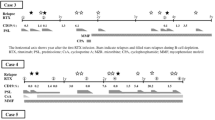Abstract
Background
Rituximab (RTX) has been shown to be an efficient treatment for steroid-dependent nephrotic syndrome (SDNS). A long B cell depletion period seems to improve the duration of remission. This study reports the duration of B cell depletion after each RTX infusion in patients with nephrotic syndrome.
Methods
We retrospectively report the data of 22 patients with a diagnosis of a SDNS or steroid-resistant nephrotic syndrome (SRNS) and a treatment with RTX in a single center. B cell depletion duration was compared to the first B cell depletion duration and to the previous B cell depletion duration in each patient.
Results
Twenty-two patients (5 girls) were included. Seventy-six periods of B cell depletions were compared to the first B cell depletion duration and to the preceding B cell depletion duration in the same patient. Total duration of B cell depletion was 26 (6–66) months. Individual post-RTX infusion B cell depletion duration was 5.1 (1.6–14) months. Median B cell depletion duration following the first RTX cure for children who had received 1 to 2 infusions at first cure was not statistically different of those who had received 3 to 4 infusions (p = 0.18). Comparing the B cell depletion induced by previous RTX courses and the following B cell depletion, 89.5% of patients had a similar duration within an open interval from 2 months.
Conclusion
Once the individual time interval until B cell recovery is determined, monitoring could be individualized by targeting the expected date of B cell recovery or by performing pre-emptive RTX injections.

Similar content being viewed by others
References
Tokunaga M, Saito K, Kawabata D, Imura Y, Fujii T, Nakayamada S, Tsujimura S, Nawata M, Iwata S, Azuma T, Mimori T, Tanaka Y (2007) Efficacy of rituximab (anti-CD20) for refractory systemic lupus erythematosus involving the central nervous system. Ann Rheum Dis 66:470–475
Iijima K (2011) Rituximab for childhood refractory nephrotic syndrome. Pediatr Int 53:617–621
Sellier-Leclerc A-L, Baudouin V, Kwon T, Macher M-A, Guérin V, Lapillonne H, Deschênes G, Ulinski T (2012) Rituximab in steroid-dependent idiopathic nephrotic syndrome in childhood--follow-up after CD19 recovery. Nephrol Dial Transplant 27:1083–1089
Iijima K, Sako M, Nozu K, Mori R, Tuchida N, Kamei K, Miura K, Aya K, Nakanishi K, Ohtomo Y, Takahashi S, Tanaka R, Kaito H, Nakamura H, Ishikura K, Ito S, Ohashi Y (2014) Rituximab for childhood-onset, complicated, frequently relapsing nephrotic syndrome or steroid-dependent nephrotic syndrome: a multicentre, double-blind, randomised, placebo-controlled trial. Lancet 384:1273–1281
Kemper MJ, Gellermann J, Habbig S, Krmar RT, Dittrich K, Jungraithmayr T, Pape L, Patzer L, Billing H, Weber L, Pohl M, Rosenthal K, Rosahl A, Mueller-Wiefel DE, Dötsch J (2012) Long-term follow-up after rituximab for steroid-dependent idiopathic nephrotic syndrome. Nephrol Dial Transplant 27:1910–1915
(2012) Chapter 3: Steroid-sensitive nephrotic syndrome in children. Kidney Int Suppl 2:163–171
Fujinaga S, Hirano D, Nishizaki N, Kamei K, Ito S, Ohtomo Y, Shimizu T, Kaneko K (2010) Single infusion of rituximab for persistent steroid-dependent minimal-change nephrotic syndrome after long-term cyclosporine. Pediatr Nephrol 25:539–544
Guigonis V, Dallocchio A, Baudouin V, Dehennault M, Hachon-Le Camus C, Afanetti M, Groothoff J, Llanas B, Niaudet P, Nivet H, Raynaud N, Taque S, Ronco P, Bouissou F (2008) Rituximab treatment for severe steroid- or cyclosporine-dependent nephrotic syndrome: a multicentric series of 22 cases. Pediatr Nephrol 23:1269–1279
Ravani P, Ponticelli A, Siciliano C, Fornoni A, Magnasco A, Sica F, Bodria M, Caridi G, Wei C, Belingheri M, Ghio L, Merscher-Gomez S, Edefonti A, Pasini A, Montini G, Murtas C, Wang X, Muruve D, Vaglio A, Martorana D, Pani A, Scolari F, Reiser J, Ghiggeri GM (2013) Rituximab is a safe and effective long-term treatment for children with steroid and calcineurin inhibitor–dependent idiopathic nephrotic syndrome. Kidney Int 84:1025–1033
Nozu K, Iijima K, Fujisawa M, Nakagawa A, Yoshikawa N, Matsuo M (2005) Rituximab treatment for posttransplant lymphoproliferative disorder (PTLD) induces complete remission of recurrent nephrotic syndrome. Pediatr Nephrol 20:1660–1663
Pescovitz MD, Book BK, Sidner RA (2006) Resolution of recurrent focal segmental glomerulosclerosis proteinuria after rituximab treatment. N Engl J Med 354:1961–1963. https://doi.org/10.1056/NEJMc055495
Nakayama M, Kamei K, Nozu K, Matsuoka K, Nakagawa A, Sako M, Iijima K (2008) Rituximab for refractory focal segmental glomerulosclerosis. Pediatr Nephrol 23:481–485
Sellier-Leclerc A-L, Macher M-A, Loirat C, Guérin V, Watier H, Peuchmaur M, Baudouin V, Deschênes G (2010) Rituximab efficiency in children with steroid-dependent nephrotic syndrome. Pediatr Nephrol 25:1109–1115
Cravedi P, Ruggenenti P, Sghirlanzoni MC, Remuzzi G (2007) Titrating rituximab to circulating B cells to optimize lymphocytolytic therapy in idiopathic membranous nephropathy. Clin J Am Soc Nephrol 2:932–937
Kamei K, Ishikura K, Sako M, Aya K, Tanaka R, Nozu K, Kaito H, Nakanishi K, Ohtomo Y, Miura K, Takahashi S, Morimoto T, Kubota W, Ito S, Nakamura H, Iijima K (2017) Long-term outcome of childhood-onset complicated nephrotic syndrome after a multicenter, double-blind, randomized, placebo-controlled trial of rituximab. Pediatr Nephrol 32:2071–2078
Author information
Authors and Affiliations
Corresponding author
Ethics declarations
The study complies with the Helsinki Declaration and was approved by the local institutional ethics committee.
Conflict of interest
The authors declare that they have no conflict of interest.
Additional information
Publisher’s note
Springer Nature remains neutral with regard to jurisdictional claims in published maps and institutional affiliations.
Rights and permissions
About this article
Cite this article
Delbet, J.D., Leclerc, G. & Ulinski, T. Idiopathic nephrotic syndrome and rituximab: may we predict circulating B lymphocytes recovery?. Pediatr Nephrol 34, 529–532 (2019). https://doi.org/10.1007/s00467-018-4139-4
Received:
Revised:
Accepted:
Published:
Issue Date:
DOI: https://doi.org/10.1007/s00467-018-4139-4




